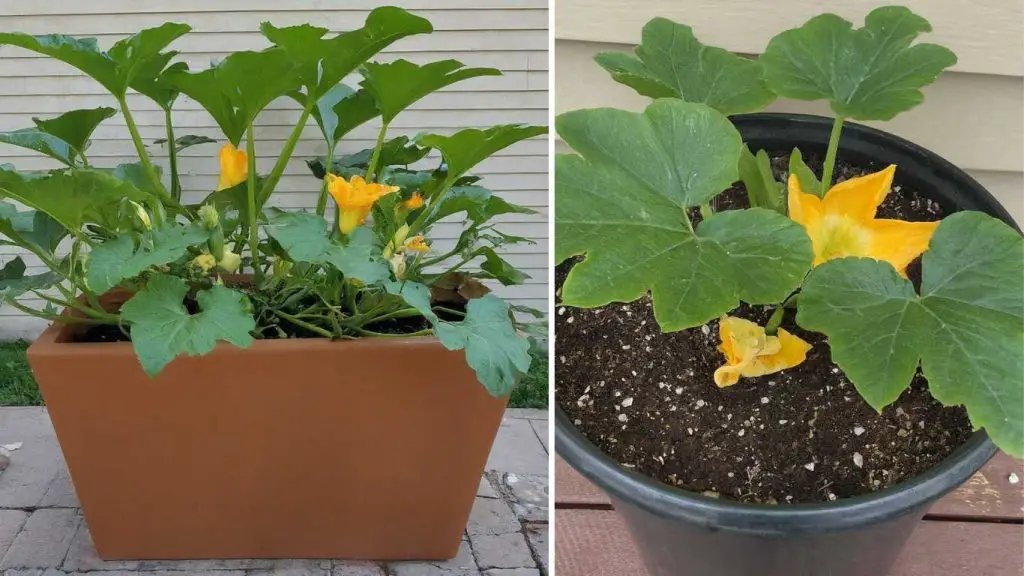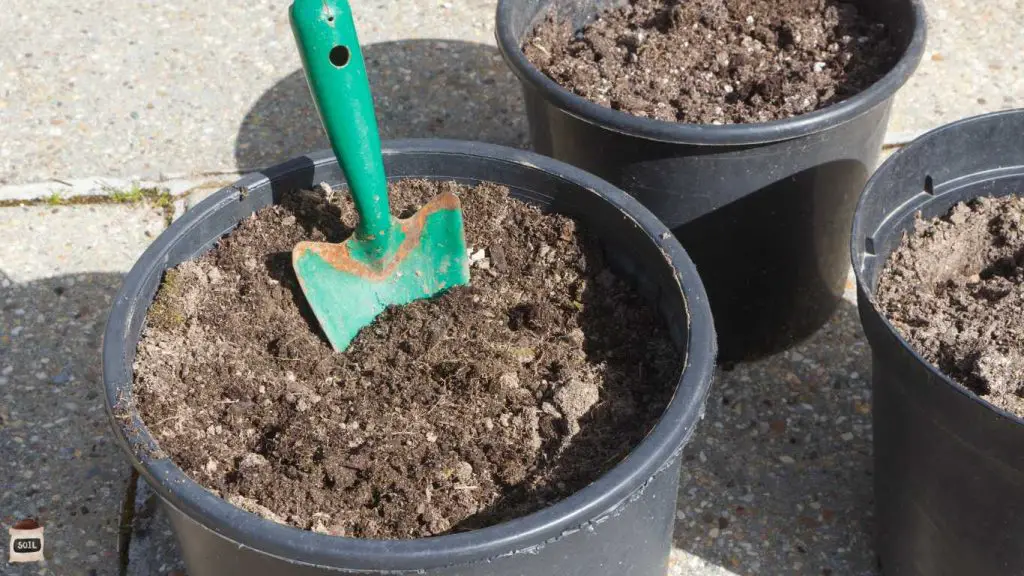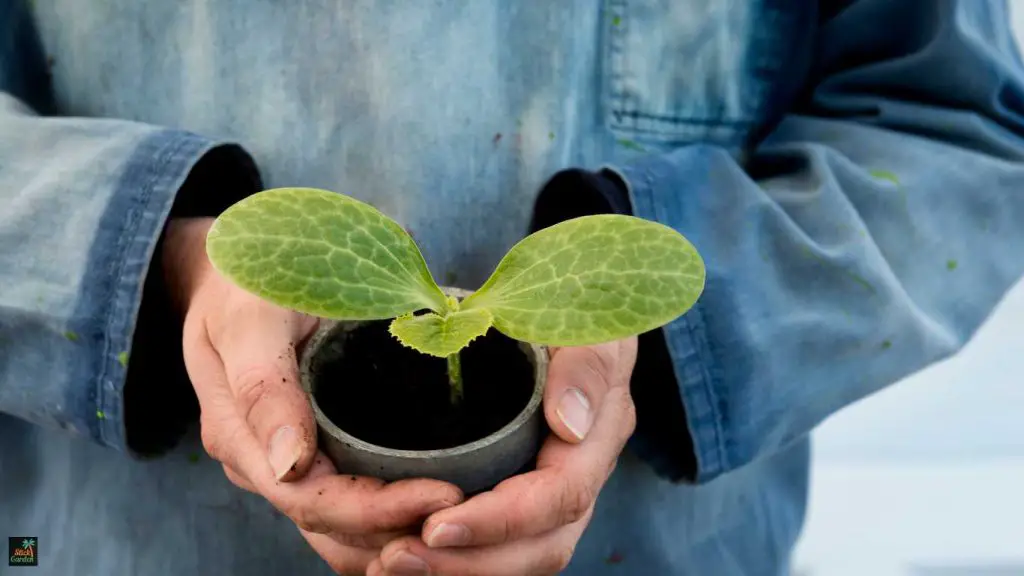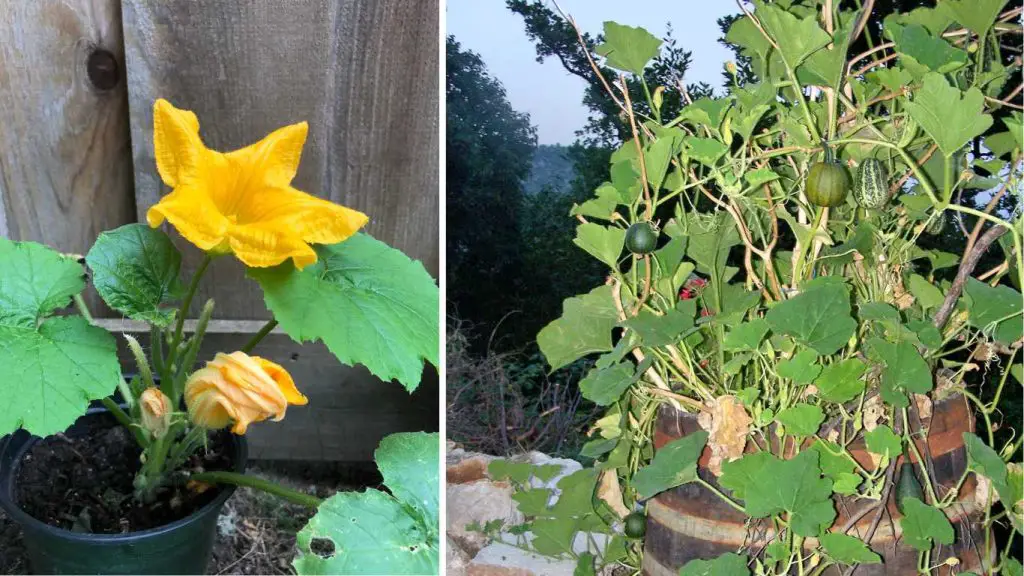Native to the Americas, squash is a vegetable belonging to the Cucurbitaceous family. It has been cultivated for thousands of years and is well-known for its edible fruits.

Vast leaves, delicate yellow flowers, and sprawling vines are characteristics of squash plants. Both male and female flowers are produced, and the female flowers bear fruit that can range in size from tiny zucchini to huge pumpkins.
Growing squash is popular among both home and commercial growers because it grows well in warm climates with well-drained soil and plenty of sunlight. With the right care, it can yield large yields.
Choosing Containers
Squash plants need a lot of soil and room to grow, so the right size container for growing squash depends on the variety and the amount of space available.
Large and small varieties of containers: While smaller varieties like patty pan or zucchini can be grown in slightly smaller containers, larger squash varieties like Hubbard or Butternut should be grown in containers that are 20–24 inches deep and of a similar width.
Depth and wide: Larger containers allow for more vigorous growth. Squash plants need wide, 18–24-inch containers for sprawling vines and deep, 18-inch containers for root growth.
Materials: While aesthetics and regular watering may be necessary, the lightweight and moisture-retention qualities of container materials like plastic, ceramic, or wood are essential.
Make sure there are enough bottom drainage holes in the container you choose to avoid waterlogging and root rot.
Related:
- Recycled Container Vegetable Gardening
- 10 Best Diy & Cheap Container Vegetable Gardening Ideas Anyone Can Use
Soil Preparation

Whether planting in garden beds or containers, choosing the proper soil mixture for squash planting is essential because of the unique requirements of the plants.
Loamy Soil: Well-draining, nutrient-rich loamy soil—a well-balanced blend of sand, silt, and clay—is ideal for squash plants. Compost and other organic matter can enhance the fertility and texture of the soil.
PH Level: Soils that range in pH from 6.0 to 7.5, which is slightly acidic to neutral, are ideal for squash plants. With a soil testing kit, test the soil and make any necessary adjustments. Use premium potting mix for container gardening to ensure proper drainage and aeration.
Nutrient Content: Squash plants need a lot of nutrients to grow healthily, so for a balanced, consistent supply throughout the growing season, use slow-release or organic fertilizers along with a rich organic soil mix.
Squash plants need adequate drainage to avoid root rot. Avert heavy or compacted soils. Mulching provides an ideal growing environment by preserving soil moisture, suppressing weeds, and regulating temperature. It can also be applied to grass, straw, or leaves.
During the growing season, you can guarantee healthy growth and plentiful squash harvests by selecting the appropriate soil mix and giving your plants the care they need.
Related Posts:
- How To Make Potting Soil At Home For Container Gardening
- How To Make Compost At Home Using Kitchen And Garden Wastes
Planting

When to plant squash depends on its variety and location; it thrives in temperatures between 70°F and 95°F. Planting should take place in the general range of 21°C to 35°C.
Seed Starting Indoors: To reduce transplant shock and provide a head start for short growing seasons, start squash seeds indoors three to four weeks before the last frost. Use biodegradable pots for this purpose.
Spacing: The ideal distance between squash plants is 3 to 6 feet, contingent on the type—bush or vining—and the variety.
Once the soil reaches 60°F (15°C) and the frost has passed, transplant squash seedlings outside. Direct seeding takes place at 60°F (15°C) or after the last frost date. Squash plants grow best in rich, well-drained soil that has a pH of 6.0 to 6.8.
Sunlight: Select a spot that receives six to eight hours of direct sunlight per day, and keep the soil consistently moist, especially when squash plants are in the flowering and fruiting stages.
Care and Maintenance

Watering: Certain watering guidelines are necessary for the healthy growth and maximum fruit production of squash plants.
Consistent Moisture: Consistent moisture is necessary for squash plants, particularly during the flowering and fruiting stages. Deep watering is also necessary to promote root development and prevent foliage from becoming wet, which can lead to disease.
Morning Watering: Avoid watering squash plants late in the day or at night and water them in the morning to allow the foliage to dry before dusk, which lowers the risk of fungal diseases.
Drip Irrigation or Soaker Hoses: When watering squash plants, drip irrigation or soaker hoses work well because they slowly release water into the soil, reduce evaporation, and guarantee that the roots receive enough moisture.
Avoid Overwatering: Although squash plants need regular moisture, overwatering for an extended period of time can cause root rot. In order to avoid this problem, proper drainage is essential.
Fertilizing Schedule And Methods
Squash plants that are properly fertilized will grow quickly, have healthy foliage, and bear an abundance of fruit.
Organic Fertilizers: For slow-release nutrients that improve soil health over time, feed squash plants with organic fertilizers such as compost, fish emulsion, or seaweed extract.
Avoid Excessive Nitrogen: It’s important to avoid over-fertilizing squash plants with high-nitrogen fertilizers, especially after flowering, as this can impede fruit production.
Soil testing: In order to modify fertilization techniques to meet the unique requirements of squash plants, soil testing is an essential technique for determining the pH and nutrient levels of the soil.
Pruning For Airflow And Pest Control
Squash plants that have been pruned will have better airflow, less disease pressure, and better pest control. Among the methods of pruning are:
Remove Diseased: To stop the spread of disease, regularly check squash plants for symptoms of illness and remove any affected leaves. Trim extra foliage, especially in areas that are crowded or shaded, to preserve airflow and avoid fungal diseases.
Sanitation: To stop pests and diseases from hibernating in plant debris, routinely clean the garden area by clearing away spent plant material, fallen leaves, and debris.
Prune Lateral Branches: Prune lateral branches by removing side shoots along the main vine in vining squash varieties such as butternut squash or pumpkin to improve airflow and decrease crowding.
Pruning can improve airflow, lower the risk of disease, and control pests better, all of which contribute to healthier plants and increased yields.
Support and Training (for climbing varieties)

Stakes or trellises can conserve space, lower the risk of disease, and make harvesting squash plants—especially vining types like cucumbers, butternut squash, or pumpkins—easier.
Choose the Right Support: To support the fruits and vines of the squash plant, choose a sturdy plastic, metal, or wood trellis or stake system. Before planting, position the stakes or trellis on the side that receives the most sun exposure.
Supporting Heavy Fruits: Fruit squash needs extra support to avoid damaging the vine. Use pantyhose slings or discarded fabric to evenly distribute the weight.
For healthy plant development, keep an eye out for pests and diseases, adjust the trellis or stakes as necessary, and take prompt action to address them.
Preparation: Before planting squash seeds or seedlings, set up a trellis or stakes in the ground 1-2 feet apart. For optimal airflow and sunlight penetration, plant 2-3 feet apart, following the variety’s recommended spacing.
Common Problems and Solutions
Controlling pests: Squash growth depends on efficient pest management, which includes managing common pests like vine borers and squash bugs.
Monitor Regularly: Keep an eye out for pest infestations on your squash plants and hand-pick any that need to be removed to ensure timely action and minimal damage.
Neem oil: Neem oil is a naturally occurring insecticide that works well against vine borers and squash bugs when sprayed on afflicted plants after being diluted with water. Neem oil is derived from the neem tree.
Crop Rotation: Pest populations in squash plants can be decreased with the aid of crop rotation, traps, and organic insecticides. To break the life cycles of pests, rotate crops with different families every year.
Place traps close to plant bases for effortless removal. Use organic insecticides that are approved for organic gardening if severe infestations continue.
Diseases
Powdery Mildew (Pedosphere spp.)
A fungus called powdery mildew grows on fruits, stems, and leaves, distorting or yellowing the leaves. It grows best in warm, muggy weather.
Plant resistant cultivars, proper spacing, irrigation, early fungicide application, and removal of infected material are all part of prevention.
Bacterial Wilt
Squash plants that have bacterial wilt, which is brought on by cucumber beetles, experience abrupt leaf wilting and collapsed vines.
Utilizing plant-resistant cultivars to lessen soil pathogen accumulation, rotating crops, removing infected plants, and applying row covers are all part of prevention.
Downy Mildew
A fungus called downy mildew causes upper leaf yellowing and mold growth on the undersides of leaves. It spreads quickly,
However it can be stopped by using fungicides, plant-resistant varieties, and adequate air circulation.
Maintaining ideal growing conditions for healthy plants, avoiding planting squash in the same spot, and routinely cleaning gardening tools are all ways to prevent disease.
Harvesting
For the best flavor and texture, squash should be harvested at the appropriate time. These general guidelines will help you identify which varieties of squash are ready to be harvested.
Check the Size: Harvest squash when it reaches its full size; learn what the average size of the variety is. Make sure the color is bright and uniform with no hint of green, similar to butternut squash, which should turn a deep beige or tan.
Timing: When butternut or acorn squash are ready, harvest summer squash when it’s tender, about 8 to 9 inches long, or winter squash when it’s hardened, to bring an end to the growing season.
Use Sharp Tools: To prevent damage and achieve clean cuts, harvest squash with sharp tools. To ensure that the fruit is sealed off, harvest early in the day when the temperature is lower. To prevent breaking off of the fruit, do not handle it by yourself.
Growing squash in pots is a productive and efficient way to grow fresh produce in small areas. Use this guide to take care of your plants: pick the appropriate size container, give them water, sunlight, and nutrients; also, be on the lookout for pests.
